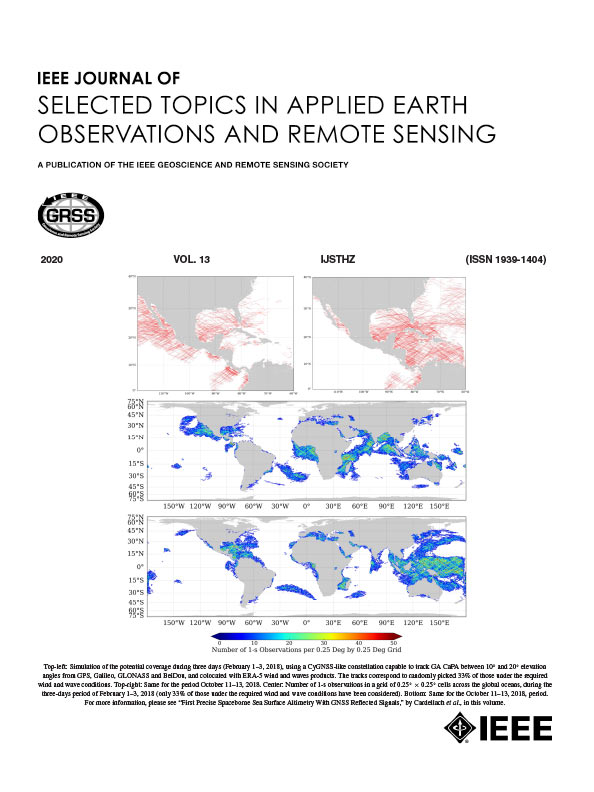Exploitation of ARIMA and Annual Variations Model for SAR Interferometry Over Permafrost Scenarios
IF 4.7
2区 地球科学
Q1 ENGINEERING, ELECTRICAL & ELECTRONIC
IEEE Journal of Selected Topics in Applied Earth Observations and Remote Sensing
Pub Date : 2025-03-11
DOI:10.1109/JSTARS.2025.3550748
引用次数: 0
Abstract
The temperature change is expected to induce nonlinear characteristics in the annual fluctuation of permafrost. The interferometric synthetic aperture radar (InSAR) technique has demonstrated its efficacy in capturing such variations by monitoring surface deformation over time. However, turbulent atmospheric phase noise often requires spatiotemporal filtering, resulting in a loss of temporal resolution for nonlinear signals. Furthermore, the influence of interannual temperature variations on annual freeze–thaw cycles has not been fully integrated into InSAR modeling thus far. In this study, we propose a methodology to enhance the effectiveness of InSAR time-series analysis in permafrost environments. Diverging from conventional filtering methods where the temporal resolution loss depends on the size of the convolution kernel, we introduce the autoregressive integrated moving average model to extract the nonlinear deformation signal component. Additionally, we derive parameters associated with annual variations from the time-series deformation data during InSAR permafrost modeling. Through synthetic data experiments incorporating various noise delays, we observe a considerable improvement in accuracy, ranging from 27.8% to 55.3% in nonlinear time-series deformation analysis. Leveraging Sentinel-1 datasets from 2017 to 2021 alongside ground truth data from northern Alaska, we ascertain an enhancement of over 22% in the accuracy of time-series deformation estimation. Furthermore, incorporating annual variations enhances the accuracy of active layer thickness estimation. Our methodology reveals a strong correlation between residual deformations and soil moisture content, shedding light on the pivotal role of soil moisture in permafrost thawing processes.多年冻土情景SAR干涉测量的ARIMA和年变模型的开发
预计温度变化将引起多年冻土年波动的非线性特征。干涉合成孔径雷达(InSAR)技术已经证明了其通过监测地表变形随时间的变化来捕获这种变化的有效性。然而,湍流大气相位噪声往往需要进行时空滤波,导致非线性信号的时间分辨率下降。此外,年际温度变化对年冻融循环的影响迄今尚未完全纳入InSAR模式。在这项研究中,我们提出了一种方法来提高多年冻土环境下InSAR时间序列分析的有效性。与传统滤波方法的时间分辨率损失依赖于卷积核的大小不同,我们引入了自回归积分移动平均模型来提取非线性变形信号分量。此外,我们从InSAR永久冻土模型的时间序列变形数据中得出与年变化相关的参数。通过包含各种噪声延迟的合成数据实验,我们观察到非线性时间序列变形分析的精度有相当大的提高,范围从27.8%到55.3%。利用2017年至2021年的Sentinel-1数据集以及阿拉斯加北部的地面真实数据,我们确定时间序列变形估计的精度提高了22%以上。此外,考虑年变化可以提高活动层厚度估计的精度。我们的方法揭示了残余变形和土壤水分含量之间的强相关性,揭示了土壤水分在永久冻土融化过程中的关键作用。
本文章由计算机程序翻译,如有差异,请以英文原文为准。
求助全文
约1分钟内获得全文
求助全文
来源期刊
CiteScore
9.30
自引率
10.90%
发文量
563
审稿时长
4.7 months
期刊介绍:
The IEEE Journal of Selected Topics in Applied Earth Observations and Remote Sensing addresses the growing field of applications in Earth observations and remote sensing, and also provides a venue for the rapidly expanding special issues that are being sponsored by the IEEE Geosciences and Remote Sensing Society. The journal draws upon the experience of the highly successful “IEEE Transactions on Geoscience and Remote Sensing” and provide a complementary medium for the wide range of topics in applied earth observations. The ‘Applications’ areas encompasses the societal benefit areas of the Global Earth Observations Systems of Systems (GEOSS) program. Through deliberations over two years, ministers from 50 countries agreed to identify nine areas where Earth observation could positively impact the quality of life and health of their respective countries. Some of these are areas not traditionally addressed in the IEEE context. These include biodiversity, health and climate. Yet it is the skill sets of IEEE members, in areas such as observations, communications, computers, signal processing, standards and ocean engineering, that form the technical underpinnings of GEOSS. Thus, the Journal attracts a broad range of interests that serves both present members in new ways and expands the IEEE visibility into new areas.

 求助内容:
求助内容: 应助结果提醒方式:
应助结果提醒方式:


